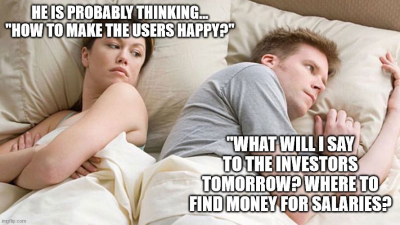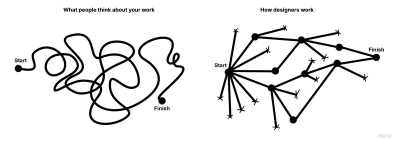Effective Communication For Everyday Meetings
Good communication is not about forcing everyone to say “Yes” or to sell something to people that they don’t want to buy. Good communication is about sharing your ideas as clearly as possible during the time you have allocated to the meeting. To do this well, you need to have a suitable structure based on the timing and people’s background knowledge.
In the following article, I will try to explain how to prepare this structure and give you some tips based on my own design experience.
We all like to listen to good stories. Good stories involve us and don’t need additional efforts to follow the ideas they present. There is no simple answer as to what makes a story good, but we can subconsciously tell what makes it bad, such as illogical storytelling structure, unclear motivation of the main hero, lengthy descriptions of some obvious things, and so on. All those aspects impede us from understanding what is going on. I can often observe something similar during regular meetings. At first, everybody goes with their communication plan, but in the end, it often turns into a flow of random sentences and abbreviations, and then at the end of the meeting, everyone tries to keep their initial opinions.
If you want to avoid such poor meeting outcomes, follow me along. Here is a guide based on my personal experience, and I hope it will help you conduct more effective meetings, too.
Сonscious Participation Or Conduction
There are two reasons why meetings happen:
- You want to present or discuss something with a few people.
- Somebody thinks inviting you to a conference/meeting is a good idea.
Each one of these reasons dictates a different preparation strategy.
Reason 1: You Are The Initiator
Start with the question, “Why does this meeting have to take place?”
Don’t get me wrong, but I haven’t actually met people who actually like meetings.
The truth is that people do their work in-between sessions. When you are in a meeting, you can’t do your work. You are distracted when you get a reminder about a meeting starting in 15 minutes. And after a one-hour session, you also need time to get back to work and to switch your mind to the things you were doing before the meeting. And being constantly distracted by meetings affects not only programmers but also designers.
So, rule No.1 is:
In 99% of the cases, a meeting takes more working hours than the time preallocated to it.
What can we do to improve the situation?
- Invite people whose work is directly related to your meeting’s key topic.
- Prepare and share the agenda in advance. People must understand why they should be there and what you will expect from them.
- Describe the goal and the expected results so participants can prioritize the information they get during the meeting.
- Plan the timeslots based on the agenda and the number of participants. If you have twenty people for a 30 minutes meeting, then everyone would have a 90 seconds timeslot. Just remember this fact.
Note: Here, I don’t mean a presentation when you deliver some information to a group of people without the need for receiving feedback or just for hearing “yes” or “no” once the presentation ends.
Sometimes it’s hard to stop inviting people to a meeting because they may all look involved in the topic. So, ask yourself, “Will I cancel this meeting if that person cannot participate?” If the answer is “No,” then just go to the next participant in the list, and so on.
Rule No. 2:
The meeting is mainly for the tasks and decisions you cannot fulfill alone.
Of course, you can say that meetings keep the team together and help understand other project areas better. There are approaches based on regular meetings, such as Scrum, and I agree with that. But we talk about effective meetings now. Because if you invited ten people with an hourly rate of $ 50, the one-hour meeting session would cost you $500. Is this a reasonable price for a one-hour small talk?
Reason 2: You Are Invited As A Participant
In this case, you are on the opposite side. It means that you can (and should):
- Ask in advance for the agenda and the goal of that session if this info is missing.
- Clarify what would happen if you could not join, and then decide on joining the meeting (or not).
- Prepare your communication plan based on the timeslot you have.
- Investigate the documentation available on the topic so you can have some background and ask the right questions.
Preparing The Communication Plan
“If you don’t know where you’re going, any road will get you there.”
— Said once the Cheshire Cat to Alice in Wonderland
Or
“Having no destination, I am never lost.”
— Ikkyu
A communication plan is like a lantern that helps you keep the right track in the darkness of routine. When everything gets worse, you can count only on this communication plan, or at least on plan “B,” which you should have. And, unlike the Cheshire Cat, you definitely need to have a plan where you want to go!
Before starting, you need to ask yourself a few questions:
- What do I want to get as a result of this meeting? Why do I go there?
- How did I come up with the idea I want to present?
- Why are other ideas, approaches, or alternative ways not so good? Have I explored all the options?
- If I understand the weak side of my ideas, what strategy should I follow? Should we touch upon them in this meeting?
Answering these questions will help you clarify your vision first, as it’s impossible to communicate an idea effectively to somebody else if it is even unclear to you.
So, let’s get back to the things you want to communicate. Do you want approval for a new feature/mockup/technology, or do you want to gather various opinions and vote for the best option? Have you tried to solve it in a few different ways, and can you argue why other methods would work worse than this one? Are you open to discussing advice about improving your proposal, or do you think it’s already good enough?
Knowing the answers to these questions would make it much easier to move communication in the right, more productive direction. Otherwise, you will spend some time finding out the answers directly during the meeting.
Also, keep in mind the personal goals of the participants. When I was twenty, I was a freelancer and needed to chase projects. I completed over one hundred projects (mainly small-sized) and had a hundred kick-off meetings. When you are a freelancer, it means that during such kick-offs, you are trying to sell your service. At first, I was trying to explain the value of my designs, the excellent conversion of my landing pages, and how happy the users would be. Sometimes this approach worked, sometimes not.
I asked for feedback from a few people who didn’t want to buy my services. Once, I got honest feedback from a manager along these lines, “I’m a manager. I don’t care about customers or conversion rates. My goal is to complete the project on time and get my bonuses at the end of the year. Can you do it on time?”

When you double-check your communication plan, make sure it matches closely with the goals of the people you want to communicate with.
Conduction Of The Meeting
A smooth start
The worst thing you can do is go to a meeting, show something during the first minute and say, “This is it! Is it looking great?”
It’s like if you were trying to explain the movie Titanic as a man keeping a little cold piece of wood afloat in the Atlantic ocean and a woman trying to fit on that ice-cold piece of wood. Yes, that’s the scene when we usually cry during the movie, but we are not crying because of this scene — but because of the long and important set of events that brought Rose and Jack there.
So, start with the story that will help your audience dive into the right atmosphere. It could be the context of using the product, the moment when somebody meets the problem you are attempting to solve or something else that can help build a smooth way to the first piece of visual information or thesis. Don’t let people use their explanations about what they see now. Human imagination works faster than your talk, so getting them back to what you are saying will be challenging.
Also, it’s always good to deconstruct the idea and explain what was before. What is the reason why we do this? What did we discuss during the previous meeting, and where did we stop? What limitations do we have? What kind of information did we learn about the market, users, or competitors that should be shared here? The people around you should have these pieces of background knowledge to better understand the potential of your ideas. You shouldn’t tell everything you know. Remember that this is just an intro, and you need time for the “main dish.”
Switching Between Scenes And Ideas
When you move between details or screens, also tell your audience about the ways which may potentially lead to some dead-ends during your progress. The filament bulb may have looked small and simple when it was ready for mass production, but Thomas Edison (and not only he) conducted more than 1500 experiments before reaching that success. Tell people also about the failures to show the broader scope of work, and when you do so, this will give people the answers to the unasked questions — why you turned this way and not some other way. Those things might not be obvious at all to the people not as deeply involved in the project as you are.
The right side of the following illustration nicely demonstrates the way product designers work. I also strongly recommend talking about the “underwater side” during meetings. It helps to unfold the final result.

The most sensitive thing is to be able to present complex ideas during a conversation. You need some time to outline a basic concept, yet people may start asking questions even before you end up with the explanation. Most of the questions won’t be asked if the participants can see the whole picture, and the solution to this is pretty easy.
Warn that first, you will only outline the idea or the solution, and after that, you will go through that again step by step, answering all the questions in the proper context. It allows you to talk to an audience that understands your idea but can ask questions in the appropriate context. Using this approach, you can smoothly move from topic to topic and not make people wait till the end of the meeting to ask questions.
Depending on your soft skills, you will have different levels of engagement with your audience. So I recommend from time to time checking this through a dialogue with the audience. The simplest way is to ask, “Are you still following me?” But it’s a bit too direct, and there are many other, more subtle ways of ensuring you have an audience that follows you. We want every minute of the meeting to be valuable, right?
A Few Hints As To How To Keep People Involved:
Ask people to highlight the aspects they know better than you.
It can be a few words about using the product in real life, market information, limitations, and so on.
Ask people to express their expectations about the next presentation slide.
It helps you focus on the crucial things for the participants. Then, even if those expectations are not reflected in your solution, you have already been informed. So you can explain why you didn’t cover them or propose a plan for how to do that.
Use questions that can be answered with a “Yes,” “No,” or only a few words.
“Does this feature make sense?”, “Are we happy with the positioning of this red button?”, “Is it clear what would happen if I click here?” and so on.
If it’s an online meeting, ask people to turn on their cameras (if possible).
It’s easier to understand what’s happening if you see the people’s eyes. But, for many different reasons, people do not always like using cameras. So, be polite and explain why it is important to you and be honest. Here is a list of reasons that I compiled:
- “I feel uncomfortable if I don’t see the people I am talking to.”
- “I think I sound like a radio DJ. Could you please turn your camera on?”
- “I’m a bit nervous when talking to the empty screen.”
- And so on.
It’s better to say this while still inviting the people so they have time to prepare their cameras and backgrounds (real or virtual) in advance.
Sometimes your questions will meet the silence on the other side. There can be a lot of reasons why this happens, but it usually means that people don’t understand what you mean or maybe that you have invited introverts to the meeting. :-)
You need feedback that helps you understand the situation and get out of this corner. And if nobody wants to provide some feedback and critique, you must become your first critic. We do not live in an ideal world, and you probably know your idea’s weak sides and limitations. So speak about them loudly and show people that it’s OK for you (and for them!) to point out the wrong things if they happen because of your design decisions.
I don’t remember the name of the book where I read about this curious fact, but one company always included paid provocateurs in the focus groups to help people start talking about the issues in the company’s product. As a result, people provided a few times more feedback than before.
Managing Contexts
When everything looks fine, and your meeting appears on the right track, don’t forget to check whether all people are in the same context. For example, when you say, “On this page, the user makes a route from A to B,” everybody thinks about his own experience. So you have to take a step back and clarify how users do this and what obstacles they will encounter because your stakeholders usually are not your users; they stand on the business side.
Also, don’t forget about emotions. Here in Ukraine, we have a proverb, “The well-fed will never understand the hungry.” So, to understand the user, you should try to walk in his shoes. Help stakeholders understand the user through emotions as well. What’s going on when a user opens your app? Does the user have enough time to learn how to complete his task? What would happen if not? All those things will not be apparent to people looking at the static design image from your slide. Tell the story! We all like stories.
Conclusion
Before wrapping things up, a note about meeting notes. There is a common practice to take meeting notes, but personally, I’m not a fan of this. Of course, taking notes is OK if you have time or if somebody can write down the main ideas discussed. But don’t allow this to dictate the pace of the discussion. The goal is to move forward but not to make pauses because you need to time a few sentences.
Meeting notes are about the past, and in order to go ahead, you need the action plan. The action plan is the list of actions that need to be done before a few predefined deadlines are reached. All items in that list should be measurable and split into a few simple, understandable steps.
An example of an ineffective action plan:
- Finalize the concept.
- Think about better navigation.
- Discuss the design concept with the users.
An example of an effective action plan:
- Add a full search flow and a “Contact Us” page.
- Create a minimum of two versions of the design concept with navigation based on best practices.
- Conduct unmoderated user testing with at least five users.
Also, every item in the list should have a person assigned to it — an “action person.” It allows avoiding a situation where something is not done just because everybody thinks it’s not in their direct area of responsibility or a list of to-do items.
I hope this article will help you organize more productive meetings, save everyone’s time, and be more efficient. And if you have questions, I’d happily reply to them in the comments below.
A few extra tips:
- The initiator is responsible for achieving the meeting results. So if you see that the discussion moves in the wrong direction, you are the person who should get it back onto the right track.
- Sometimes, somebody may say, “As we are all here, can we also discuss…” Nope, it doesn’t work like that. The correct thing to do is to cover the agenda first, and then, if everyone agrees (and there’s some meeting time left!), you can discuss something else.
- If you invite people who don’t know each other, it’s best to start by introducing everybody.
- You can record the meeting; it’s a good option for people who can’t join. But before the recording is made, ensure everybody is OK with that.
- Don’t make people ask about dropping off the meeting if/when the time is up. Instead, if you need more time, ask about a possible extension 5-10 minutes before the end of the scheduled timeslot and then adjust your plan accordingly. Discussing ideas with people who are late somewhere else is a bad idea, especially if the topic is complex and rather important! Make sure that it’s comfortable for everyone to extend the meeting a bit; if it is not, leave some of the topics and discussions for another time.
- The traditional approach dictates you should invite all people related to one or more of the topics on the meeting agenda. But if you can discuss and resolve some of the questions in smaller groups or one-to-one meetings, please go this way; it’s much better. Ideally, every participant has to be involved in every aspect of the meeting plan. (It doesn’t feel right to join the forum only because of a five-minute question that concerns you, placed at the end of the meeting time.)
- Try to hear the others. Unfortunately, sometimes we are so focused on our vision and following a plan that we can ignore the voices around us. As a result, good ideas may not get a chance to be heard and evaluated at the right time.
Further Reading
Here are a few additional resources on the topic of conducting effective meetings:
- “The Anatomy of an Amazon 6-pager,” Jesse Freeman
How Amazon conducts its meetings? Amazon is well known for its lack of using PowerPoint. This works because before a meeting, you print out enough copies for everyone in the room, and you’re not allowed to read the document from your computer unless you are remote. This long read will share plenty of details about how Amazon and their meetings work.
Note: During the pre-pandemic times, things were much different from what they are today, meetings included. People worked in offices and in person much more often. - Big Timer
Some teams choose a very specific duration of the meeting, e.g., 18 minutes or 23 minutes, with a large countdown displayed in front of everybody to bring the meeting to the point and right on time. - “Mental Health at Work (leverage focus blocks),” Cameron Moll
In some teams, employees are allowed to block out hours for “focus work,” and no meetings can be scheduled during that time. - “Meetings,” Paul Adams
After a fantastic meeting, everyone feels like progress was made, that things are clearer than before, and that there is continued momentum. At the same time, meetings are also expensive. Consider the opportunity cost of people being at a meeting, as they could all be doing other important things. - “Let’s Have Better Meetings!,” Laurel Hechanova & Patrick DiMichele
How to run a tighter ship and make better use of everyone’s time. - “Why Standups are Useless and How to Run Great Product Team Meetings,” Andy Johns
There’s probably one flavor of a meeting that tops the charts in uselessness, and it’s the “status update” meeting. - “The Cost of Interrupted Work: More Speed and Stress,” Gloria Mark (University of California, Irvine), and Daniela Gudith & Ulrich Klocke (Humboldt University, Berlin) [PDF document]
This is a paper about productivity, namely about meetings that “steal” from people because of interruptions.



 SurveyJS: White-Label Survey Solution for Your JS App
SurveyJS: White-Label Survey Solution for Your JS App


 Agent Ready is the new Headless
Agent Ready is the new Headless

